"An appeaser is one who feeds a crocodile, hoping it will eat him last."
-Winston Churchill
Ever wonder what will happen to the Earth once the Sun dies? Although it's happening very slowly, the Sun is burning through the nuclear fuel that powers it, giving off a tremendous amount of energy all the time as it happens.
Like all stars, the Sun burns progressively hotter as it ages. A few billion years ago, solar output was 10% less than it is today, and a few billion years from now, it will burn so hot that our oceans will boil, something that only currently happens when lava spews out into the seas!
Of course, this won't physically destroy the Earth itself, just most of the life on it. Despite the fact that today's oceans and land will become cracked and dry, and largely (if not completely) inhospitable to life, the charred, baked Earth will still be here.
And the Sun -- when it finally runs out of fuel after another five-to-seven billion years -- will go through its death cycle. It will become a red giant, burn the heavier elements like helium into carbon, nitrogen and oxygen, and will expand, engulfing Mercury and Venus, but perhaps not the Earth.
And after that, once the Sun has exhausted its fuel from those heavier elements, all it can do is blow off its outer layers in a planetary nebula, and contract down to a white dwarf at the center.
The planetary nebula is short lived, lasting only maybe 100,000 years, but the white dwarf will remain for a very long time! With an estimated lifetime soaring into the trillions of years, whatever planetary bodies are left -- and that probably includes Earth and definitely includes Mars -- should just orbit this tiny stellar corpse at the center of our Solar System.
What is this white dwarf that gets left behind like? Well, it still has most (maybe 50-70%) of the original mass of the Sun, but in terms of size it's only about the size of the Earth! The vast majority of this white dwarf will be Carbon, Nitrogen and Oxygen, with a small envelope of hydrogen/helium on the outside.
And -- with the planetary leftovers orbiting it -- you may think that takes care of everything for trillions of years. That if nothing's eaten the Earth by now, it'll simply stick around, orbiting, for the rest of its days.
Only, the Sun won't be the first to this state! Already, just within our own galaxy, there are around a hundred billion white dwarf stars, including many found in globular cluster M4, above.
But just as asteroids and comets get hurled around the Solar System by planets like Jupiter and Neptune, the same thing ought to happen around these white dwarf stars with the remaining solid bodies that orbit it.
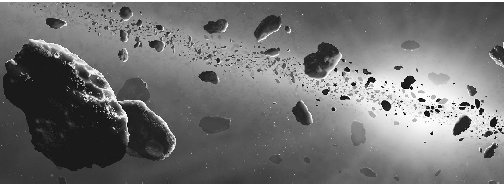
And every once in a rare while, one of these rocky bodies -- maybe an asteroid, maybe even a small planet -- should get hurled directly towards its parent star!
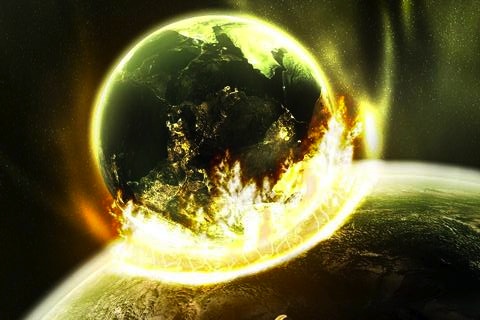
What would the aftermath of a beautiful catastrophe like this be? The remains of the planet should get kicked up in a dusty storm around the white dwarf, and we should be able to detect the presence of its heavy elements!
How's that? The white dwarf is still very hot, with a surface temperature of many thousands of degrees, so it emits blackbody radiation just like the Sun does. But these heavy atomic elements will block light at very specific frequencies, telling us what this dust is made out of, and hence how much of each type of elements this recently devoured planet or asteroid once contained. In theory, even a dwarf planet or an Earth-sized object could eventually be eaten by a white dwarf.
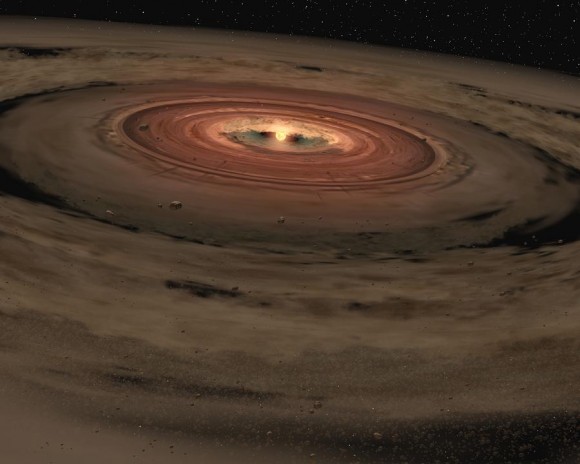
Guess what we just found?
At least four known white dwarf stars have eaten something very similar in composition to Earth in their own solar systems!
Magnesium, Chromium, Iron, Nickel, Calcium, Tin and Silicon, among many others, have been found encircling the helium envelope of these white dwarfs, in greater or equal abundance than what the planet Earth has!
The devoured planets have left a signature behind showing that they're likely somewhere in between the masses of Ceres and the Moon, shown above for comparison with Earth. But there is also something else -- of perhaps far greater importance -- than the fact that the Earth may someday be eaten by our Sun's white dwarf future. As Ben Zuckerman, one of the leaders of the study says,
This means that planetlike rocky material is forming at Earthlike distances or temperatures from these stars.
In other words, this is the first hard evidence that we have that there are not only extrasolar planets, but planets made of the same stuff that Earth is made of orbiting other stars, and they were doing it before our Solar System even formed!
Take a look at the whole paper here. Although there are a couple of good writeups of this, the best I can leave you with is the last sentence of the paper's conclusions:

Image copyright: Lynette Cook of Extrasolar SpaceArt, http://extrasolar.spaceart.org/extraso2.html.
It is clear that extrasolar planetary systems produce rocky bodies that are compositionally similar to terrestrial planets in our own solar system; Earth-like planet(esimal)s apparently do form elsewhere in the galaxy.
So while the Sun may eventually eat us in the far distant future, the fact that long-dead Suns are eating some of their planetary remnants has allowed us to find out, yet again, that Earth and our Solar System may not be so special after all.



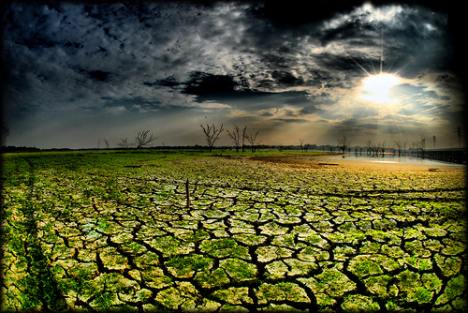
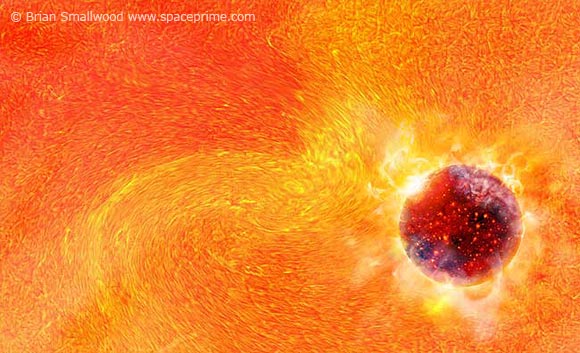
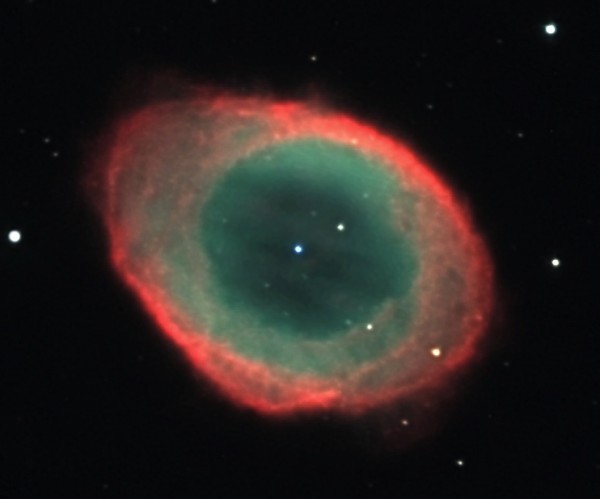



Don't ya get it? The Earth and our Solar System are special because we are here. Thank God for that :)
"That if nothing's eaten the Earth by now, it'll simply stick around, orbiting, for the rest of its days"
White dwarfs are stable, their lifetime is pretty much indefinite (barring collisions/mergers with something big enough to make them go Supernova). AFAIR, only exotic things like proton decay or maybe tunneling into neutron star/black hole state can do them in.
Earth is not so safe. Its orbit will slowly decay due to gravitational radiation. I think, it requires about 10^15 years for it to decay.
If humans don't go extinct earlier, then the Earth will be moved to prevent its destruction when the Sun becomes a red giant.
The way it will be done is to take various asteroids and move them onto orbits that add/subtract the appropriate momentum to the Earth at each flyby, which then takes the asteroid past Jupiter for another flyby, and another and another. If you take the calculations out far enough the motion becomes chaotic, which is what you want because then it takes differential levels of energy/momentum to change the trajectories.
Ideally you use all the loose objects in the solar system to do this. Once you can get Mars liberated and in an Earth-Jupiter circuit, then things will start moving real fast. If you time it right you can get a velocity boost from all of the large planets when Earth is liberated. At 100 km/sec you can go ~10 light years in 30,000 years. Then you do the reverse to slow it down into a capture orbit around the new sun.
Come on, a little help here? "How to eat the Earth" isn't my problem; I need to know where I can get a knife & fork in that size.
More seriously, though, I thought spectral absorption like that was more a feature of gases than of solids. Do these measurements manage to detect the difference cause by the light which does actually pass through solid bits of dust? Or is this a special definition of "dust" that includes gasses, kind of like how "metal" means any element with Z > 2 for astronomers?
Randy, those are gases. The white dwarf has a surface temperature much higher than the surface of our sun. They are looking at temperatures less than ~ 20,000 K.
The surface gravity of the WD is so high that the elements in its atmosphere settle out due to their heavier mass leaving only H and He, but that takes a while.
If the sun loses some significant portion of it's mass, how would that affect the orbits of the planets around it? Would they just move further away? Would any of the more distant objects (like pluto for example) get flung out of our solar system?
Kevin:
Yes, and in fact it'll be a race to see if the Earth will be swallowed by the red-giant Sun or if mass loss will be enough for Earth to move away. As far as models tell, it'll be pretty close either way.
Pluto will definitely be unattached, and giant planets might get to play pinball.
Aren't we (MW galaxy) scheduled for a collision with M31 (no-longer-)-in-Andromeda at about the same time as the Big Bake-Off?
Wouldn't that (at the very least) randomize orbital paths enough to scramble all predictions more specific than "Oh hell!"?
@Alex #2
I'm pretty sure white dwarfs can't supernova. They're the remnants AFTER a star goes nova. And "gravitational radiation?" What exactly is that?
Nice article; enjoyed so much.
Always this question baffling me whether we are special or not?! I think, some reasons such you've presented here are for the "we are not unique and special"; but I clearly remember I read some convincing articles which argued we are "special".
I think dividing line is not clear in the conclusion of the paper you referred. When we are comparing the earth to other planets in similar solar systems in our galaxy or somewhere else, we have to clarify this important point that the earth is a general term. In this article just atoms are considered, but to what extent those planets are the same as the earth? It's worthy to be mentioned here. Maybe our physical earth is not an special but not enough reasons support, we as humans and other animals and creatures are NOT special.
Artor, a type Ia supeernova has a white dwarf precursor.
http://en.wikipedia.org/wiki/Type_Ia_supernova
Pierce @8: Even during a galaxy collision, you can approximate star trajectories as being collisionless, which means that a given star is unlikely to have its trajectory significantly perturbed directly by passing close to another star; instead the star will respond to the combined gravitational fields of the interacting galaxies. As long as this approximation holds, inner planets should be relatively safe (Kuiper belt objects may not be).
Artor @9: When two massive objects orbit each other, general relativity predicts that they lose some of their kinetic energy to gravity waves and spiral in to one another. Presumably Alex is referring to the emission of these gravity waves as "gravitational radiation". AFAIK gravity waves have not yet been directly observed (there are some experiments on line now which should just barely be able to detect the waves emitted from some of the larger and closer interactions), but effects attributable to these waves, such as objects spiraling toward one another, have been observed, and the measurable effects have all been consistent with the predictions of general relativity. There would be an effect of this kind between Sun and Earth, but it is so small as to be effectively negligible on any time scale which is small compared to the life of the Earth (the time frame Alex mentions is four orders of magnitude longer than the expected lifetime of the solar system).
Eric Lund @ # 12: ... you can approximate star trajectories as being collisionless, which means that a given star is unlikely to have its trajectory significantly perturbed directly ... As long as this approximation holds, inner planets should be relatively safe
When galaxies collide, they can pass straight through each other or go into orbit around their mutual center or gravity or merge, or a combination of these. In any case, each star system will be subject to multiple gravitational trespasses; I strongly suspect chaotic interactions (that may be smoothed out on the macro scale) would still ellipticize previously practically circular orbits at the least, sometime during said repeated encounters.
I'd even be willing to place a $10 bet. If you do the same, and we put our wagers into an interest-bearing account, by the time we settle this question one of us will be able to retire in comfort, anywhere on the cinder.
... (Kuiper belt objects may not be).
Though the winner may have to invest in some seriously heavy-duty roofing.
Pierce, who do you have the bet on with about the immortality formula you're obviously expecting? :)
Cute comment, really made me smile.
Have we detected any background radiation from the Great Nom?
It's all probably relative. The gravitational effects on the solar system accrued from the galactic interactions will probably be locally much smaller than the gravity of the main star itself, and there should be a certain evening-out such that the star system gets affected as a whole.
Out where the parent star's gravitational influence is weak, in the Kuiper and Oort clouds, for example, would be where the galactic influences are most likely to be seen. But where the host star's gravitational influence is strong, in the neighborhood of the inner planets, the galactic influence may be swamped out by the local gravitational field.
Of course there's always the possibility of secondary effects, like a large KBO/Oort cloud object being perturbed such that it falls inwards such that's it's gravity becomes a factor on the close pass....
You cannot be certain of this. There are too many variables in play that cannot be predicted. The kind of mitigation you propose obviously requires a tremendously advanced civilization to pull off.
But there's nothing to say that a long-surviving intelligent species will automatically achieve and maintain continuously such an advanced technological civilization. It could well be, for example, that the species may turn out to be stable over several billion years (H. sapiens becomes a living fossil!) but that civilization is not. Instead there could be a continuous boom-bust pattern of civilization rising and falling again as resources are overstretched, in which case there is no predicting what the technological level of the surviving humans might be at the specific time when the sun goes red-giant. If they happen to have recently crashed to an arbitrarily low level (and it wouldn't have to be that low, too, after all, if it happened today, we'd be toast), then they're done for.
Alternately, humanity might speciate over such an extended period of time, and there's no guarantee that technological intelligence will always remain selected for.
Finally a technologically advanced future humanity capable of moving the earth may find it neither necessary or practical to do so. Why move the whole planet when it is much easier to just move yourselves off it? They may simply migrate elsewhere in the Solar System, or even just live in space in self-sustaining mobile habitats that would be free to move anywhere up and down the Sun's gravity well. They may even have colonized other stars. Perhaps they could even stop the sun's red giant expansion altogether (though I'd imagine this is even harder than moving the earth!).
Nothing to add, just wanted to pay a compliment. This is yet another fantastically written article. How is it that the stuff on this blog is so much better than the typical pop-science book?
Silly, Ethan. Don't you know His Holiness, The Flying Spaghetti Monster would save us long before the Sun cooks/engulfs the Earth? How dare you not mention His Holiness in this post?
The most recent simulation I'm familiar with (note the caveat) found that the Earth will avoid being directly consumed in the Sun's red-giant phase because the Sun will indeed lose enough mass for the Earth to move out to a sufficiently more distant orbit. However, at least according to this simulation, the Earth then finds itself in a high-drag environment (by which we mean an extremely low drag environment by any standard other than astronomy, but high for a planet.) So, the Earth very, very slowly spirals in.
Nice explanation, I didn't know.
I particularly appreciate the picture of the Earth next to a white dwarf. Thanks.
daedalus2u If we continue learning about science like we're meant to, we'll be able to escape into space by then, which will be much easier and safer than trying to bowl asteroids around. But if by then we won't have stopped using God as an excuse to deny science, He won't owe us any favors.
Only if the heavens above can be measured and the foundations of the earth below be searched out will I reject all the descendants of Israel.
but why would the earth get hurled towards the sun ... if it was supposed to get hurled, why has it not happened so far ... why only after white dwarf stage ?
maybe u r trying to say that white dwarfs live for a much much longer time than the current age of the sun .. so eventually the earth, when it gets hurled, will happen when the sun is a white dwarf ... but that again begs the question ... what will cause it ? why won't the earth just peacefully circle the sun forever ?
We were NOT created, we developed/evolved into what we are today. Humans, animals and insects are here on this planet because the conditions have made it possible. Many large animals that lived here millions of years ago simply ate themselves out of existence or died out otherwise. Some dinosaurs only gave birth or layed eggs once a year. Predators killed their offspring and eventually the entire dinosaur era died with it. Unless we wipe ourselves out, Earth will exist for another few billion years.